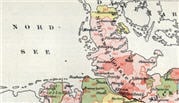Source Information

Sterberegister. Stadtarchiv Rinteln, Rinteln, Deutschland.
About Rinteln, Germany, Deaths, 1874-1957
About this collection
This collection contains death records from Rinteln covering the years 1874 up to and including 1957. Rinteln is a community in the district of Schaumburg in the German state of Lower Saxony. It is located on the Weser River about 15 miles northwest of Hamelin and borders the German state of North Rhine-Westphalia to the west. Rinteln was chartered in 1239. The historic bridge over the Weser River at Rinteln helped the city develop into an important trade center. The city skyline is characterized by numerous historic half-timber houses and buildings done in the Weser Renaissance architectural style. During the time period of this collection, Rinteln belonged first to the Prussian Province of Hesse-Nassau until 1932, then to the Prussian Province of Hannover and, after 1946, to the German state of Lower Saxony. In addition to Rinteln, the collection includes records from the communities of Deckbergen, Exten, Goldbeck, Hohenrode, Möllenbeck and Steinbergen. However, the records for these end before 1973. Death records from Steinbergen start in the year 1888.
Beginning on October 1, 1874, local registry offices were made responsible for creating birth, marriage and death records in the former Prussian provinces. The collected records are arranged chronologically and usually in bound yearbook form which are collectively referred to as "civil registers." For most of the communities included in the collection, corresponding alphabetical directories of names were also created. While churches continued to keep traditional records, the State also mandated that the personal or marital status of the entire population be recorded.
What you can find in the records
Death records were created using preprinted forms that were filled in by hand by the registrar. In each record the date of death usually differs from the date it was registered. Depending on the individual form or on the formulations used by the registrar, you may find:
- Sequential or Certificate Number
- Informant: Given Names, Last Name, Maiden Name, Occupation, Residence/Address, Denomination
- Deceased: Occupation, Given Names, Last Name, Maiden Name, Age, Denomination, Residence/Address, Place/Date of Birth, Spouse/Parents, Place/Date of Death, Time of Death
- Beginning in 1938, the records may also cross reference to corresponding birth and/or marriage registers
- From 1938 to 1957, the Cause of Death is often included
- Beginning in 1957, details may include Parents' information
- Signatures
Entries in the name directories are ordered alphabetically according to the last name of the deceased, then by year of death. They are generally bound as separate volumes covering several years each. They contain the following details:
- Last Names and Given Names of the deceased
- Cross-reference to death register
- Occupation, Address of the deceased
More about using this collection
Each record comprises one page. Additional events from the life of the deceased were sometimes recorded later on in the margins. These notes can contain very useful information but they have not been indexed. As a result, information from the notes will not found via the search form. The “Informant” was usually a relative of the deceased. In later years death information was often submitted by hospital administrators or by an undertaker. These records also document casualties (Kriegssterbefälle) from the Second World War. Records for some of the dead were only later made available by the "German Office for the Notification of Next-of-Kin of Members of the Former German Armed Forces who were Killed in Action" (WASt) in Berlin. Under "Browse this collection,” select the Civil Registration Office and Year Range of the register desired. If a name directory was created, it will be found at the end of each individual volume.
 Need help with the German language? Find resources in our German Research Center.
Need help with the German language? Find resources in our German Research Center.